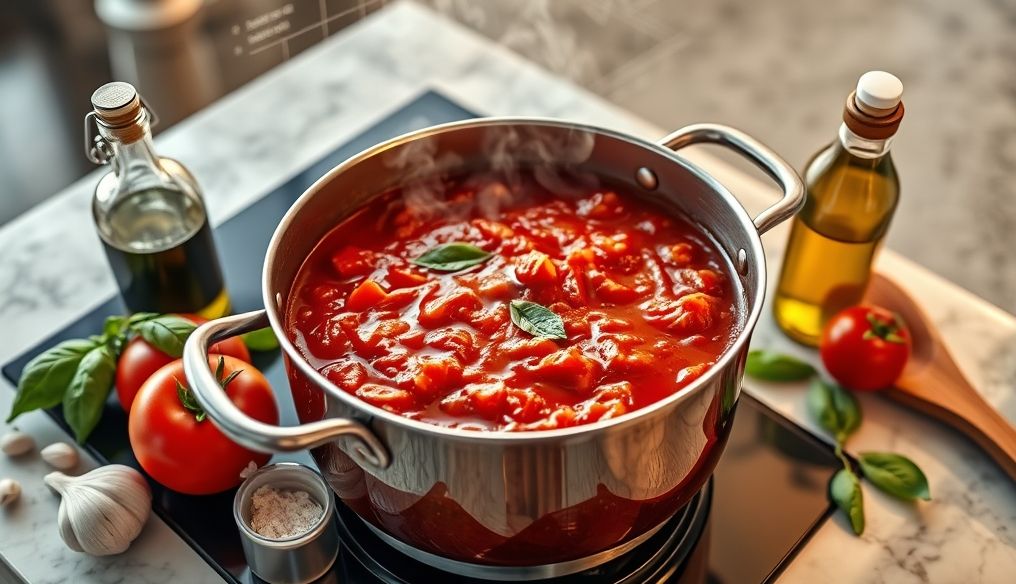Introduction: Tomato Sauce - The Heart of the Perfect Pasta Dish
Tomato sauce is more than just an addition to pasta; it's the soul and beating heart of the dish. A good sauce can transform a simple plate into a delicious feast, while a bad sauce can ruin even the best pasta. In this article, we will delve into the world of tomato sauce, exploring the secrets to preparing it perfectly, from choosing fresh ingredients to mastering cooking techniques.
Chapter 1: Choosing the Perfect Tomatoes - The Solid Foundation of Flavor
Everything starts with tomatoes. The quality of the tomatoes used significantly determines the quality of the final sauce. Here are some tips for choosing the perfect tomatoes:
- Fresh Tomatoes: In tomato season, there's no substitute for ripe, fresh tomatoes. Look for tomatoes with a deep red color, firm texture, and fragrant aroma.
- Canned Tomatoes: Out of tomato season, canned tomatoes are a good option. Choose whole peeled tomatoes preserved in their own juice. Avoid tomato paste or tomato sauce as they often contain preservatives and added sugar.
- Types of Tomatoes: Some varieties, such as San Marzano tomatoes, are considered ideal for tomato sauce due to their fleshy texture, few seeds, and balanced acidity.
Tip: If you're using canned tomatoes, look for brands that use authentic San Marzano tomatoes, which are often more expensive but worth it.
Chapter 2: Other Essential Ingredients - Adding Depth and Complexity
In addition to tomatoes, there are a few other essential ingredients that contribute to the flavor of the sauce:
- Olive Oil: Use extra virgin olive oil for a rich and fruity flavor.
- Garlic: Fresh garlic is a staple in tomato sauce. Start with a small amount and increase to taste.
- Onion: Finely chopped onion adds sweetness and depth to the sauce.
- Herbs: Fresh basil and oregano are classic herbs that pair well with tomato sauce. You can also use dried herbs, but in smaller quantities.
- Salt and Pepper: Salt and pepper are essential for enhancing and balancing the flavor.
Tip: Don't be afraid to experiment with other ingredients such as crushed red pepper for heat, or sugar to neutralize the acidity of the tomatoes.
Chapter 3: Preparation - The Basic Steps to a Successful Sauce
Now that you've gathered the ingredients, it's time to prepare. Here are the basic steps:
- Peeling the Tomatoes (if using fresh tomatoes): Make a small X-shaped cut at the bottom of each tomato. Place the tomatoes in boiling water for 30 seconds, then transfer them to a bowl of ice water. The skin should slip off easily.
- Chopping the Tomatoes: Chop the tomatoes into small cubes. If you're using canned tomatoes, you can simply crush them with your hand.
- Sautéing the Onion and Garlic: Heat the olive oil in a large saucepan over medium heat. Add the chopped onion and cook until translucent. Add the minced garlic and cook for one minute until fragrant.
- Adding the Tomatoes: Add the chopped or crushed tomatoes to the saucepan.
- Simmering: Let the sauce simmer over low heat for at least an hour, or until it becomes thick and flavorful. The longer it simmers, the tastier the sauce will be.
- Seasoning: Season the sauce with salt, pepper, and herbs. Taste and adjust the seasonings as desired.
Tip: Stir the sauce frequently to prevent it from sticking to the bottom.
Chapter 4: Advanced Techniques - Elevating Your Sauce
After mastering the basics, you can try some advanced techniques to elevate your sauce:
- Adding Wine: Adding a quarter cup of dry red wine to the sauce while cooking can add depth and complexity to the flavor.
- Using Bone Broth: Replacing some of the water with bone broth can add richness and nutrition to the sauce.
- Roasting: Roasting the tomatoes in the oven before adding them to the sauce can intensify their flavor.
- Using Roasted Vegetables: Adding roasted vegetables such as red peppers or eggplant can add a smoky and sweet flavor to the sauce.
Tip: Don't be afraid to experiment and innovate. Tomato sauce is a versatile dish that can be adjusted to suit your taste.
Chapter 5: Common Mistakes and How to Avoid Them
Even the best chefs make mistakes. Here are some common mistakes to avoid when preparing tomato sauce:
- Using Unripe Tomatoes: Unripe tomatoes will produce a sour and unpalatable sauce.
- Overcooking: Overcooking the sauce can make it bitter.
- Not Seasoning Properly: Proper seasoning is essential for balancing the flavors.
- Not Stirring Frequently: Not stirring frequently can cause the sauce to burn at the bottom.
Tip: If the sauce is too acidic, you can add a little sugar or baking soda to neutralize the acidity.
Chapter 6: Ways to Serve Tomato Sauce - Irresistible Dishes
Tomato sauce is versatile and can be used in a variety of dishes:
- Pasta: Of course! Tomato sauce is the perfect addition to any type of pasta, from spaghetti to penne.
- Pizza: Tomato sauce is the traditional base for pizza.
- Lasagna: Tomato sauce is a staple in lasagna.
- Shakshuka: Tomato sauce is the base of this popular Middle Eastern dish of eggs cooked in tomato sauce.
- Soup: Tomato sauce can be used as a base for many types of soup.
Tip: Experiment with different ways to serve tomato sauce and discover your favorite dishes.
Chapter 7: Storage - Preserving Flavor and Quality
Tomato sauce can be stored in the refrigerator for up to 5 days, or in the freezer for up to 3 months. Here are some tips for storing tomato sauce properly:
- Refrigeration: Place the sauce in an airtight container and refrigerate in the refrigerator.
- Freezing: Place the sauce in freezer-safe bags or containers. Leave a little space at the top for the sauce to expand during freezing.
- Canning: If you want to store tomato sauce for longer, you can can it using the appropriate canning method.
Tip: Label the sauce with the freezing date to keep track of its shelf life.
Chapter 8: The Perfect Tomato Sauce Recipe - A Step-by-Step Guide
Here's a simple recipe for the perfect tomato sauce:
Ingredients:
- 1 kg ripe fresh tomatoes or 2 cans (800g) whole peeled tomatoes
- 1/4 cup extra virgin olive oil
- 1 medium onion, finely chopped
- 2 cloves garlic, minced
- 1 teaspoon dried oregano
- 1/2 cup fresh basil, chopped
- Salt and black pepper to taste
- 1/4 cup dry red wine (optional)
Instructions:
- If using fresh tomatoes, peel and chop them into small cubes.
- Heat the olive oil in a large saucepan over medium heat. Add the chopped onion and cook until translucent. Add the minced garlic and cook for one minute until fragrant.
- Add the chopped or crushed tomatoes to the saucepan. If using wine, add it now.
- Let the sauce simmer over low heat for at least an hour, or until it becomes thick and flavorful. Stir the sauce frequently to prevent it from sticking to the bottom.
- Season the sauce with salt, pepper, and oregano. Taste and adjust the seasonings as desired.
- Just before serving, add the chopped fresh basil.
- Serve the sauce with pasta, pizza, or any other dish you prefer.
Conclusion: Enjoy Your Homemade Tomato Sauce
Making the perfect tomato sauce is an art and a science. By following these tips and techniques, you can prepare a delicious and flavorful sauce that will impress your family and friends. Enjoy the process and the results!




